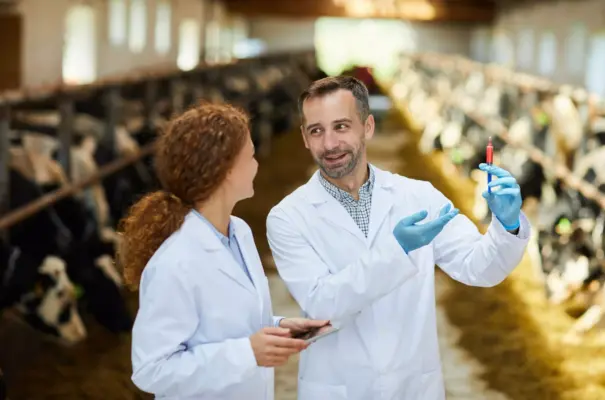Biotechnology has been a major ally in livestock farming as part of efforts to contribute to the Global Methane Pledge — an initiative launched at the 26th Conference of the Parties to the United Nations Framework Convention on Climate Change (UNFCCC), COP26, held in 2021. Led by the United States and the European Union, the initiative is supported by over 100 countries, including Brazil, which have committed to reducing emissions of this gas globally by 30% by 2030.
Numerous initiatives are underway. Among them are international research efforts conducted by renowned institutions in partnership with producers for the creation of vaccines that aim to act on the bovine digestion process, in order to mitigate the consequent methane emissions produced by cattle.
Research in New Zealand, the United Kingdom and a US Vaccine
ArkeaBio, a Boston, US-based company with global operations in agricultural bioscience, says it already has a methane-reducing vaccine that will help farmers reduce emissions without disrupting their operations. The company, founded in 2022, is in the research and development phase, but initial tests with the vaccine prototype showed a reduction of approximately 13% to 15% in methane emissions over a 105-day period. However, the company’s CEO, Colin South, stated that the efficacy and duration of the effects are not yet sufficient for a commercial product. The company expects a safe and scalable solution, one that meets the growing global demand for dairy and beef while reducing emissions, to be fully ready for the market between 2027 and 2030. The vaccine works against methane-producing microbes in the cow’s rumen, activating a natural immune response without disrupting the animal’s digestion.
In New Zealand, one of the major initiatives for creating a methane gas vaccine is the result of a consortium between Fonterra, that country’s multinational dairy cooperative, Beef and Lamb New Zealand, DairyNZ, Deer Industry NZ, AgResearch, Fertilizer Association, Landcorp, and PGG Wrightson Seeds. In an article published on Portal MilkPoint, a Brazilian information channel for the dairy sector, the chairman of the Pastoral Greenhouse Gas Research Consortium, Professor Jeremy Hill, states that this vaccine could be “a major game-changer for animal emissions” worldwide. The MilkPoint article is based on a report from the New Zealand news website Stuff. Research into the vaccine involved investments between R$13.6 and R$17.2 million per year.
Another research front is being led by The Pirbright Institute and the Royal Veterinary College (RVC), both from the United Kingdom, and by AgResearch, an agricultural innovation laboratory in New Zealand. According to an article published on the G1 Agro website, the Bezos Earth Fund, billionaire Jeff Bezos’s institute, is investing US$9.4 million (R$51 million) in the creation of a vaccine to reduce methane emissions generated by belching and gases produced during the bovine digestion process. The vaccine also seeks to induce the production of antibodies that prevent the action of bacteria responsible for generating methane within the cow’s stomach. “The appeal of the vaccine is that producers are already familiar with the general benefits of vaccination for animal health, and there is adequate infrastructure on farms to receive it,” stated John Hammond, research director at The Pirbright Institute.
In Brazil, the vaccine is also seen as one of the viable solutions to combat methane emissions, as evidenced by the study “Methane Emissions in Livestock Farming: Concepts, Assessment Methods, and Mitigation Strategies,” from the Brazilian Agricultural Research Corporation (Embrapa) Dairy Cattle. This study cites references from the RumenGases Brazil project, developed in partnership with 17 other research institutions, which aimed to study strategies for mitigating emissions from ruminants. Initiated in 2011 and concluded in 2015, one of the project’s outcomes was the establishment of Embrapa Dairy Cattle’s Multi-User Complex for Bioefficiency and Sustainability in Livestock Farming, located in Coronel Pacheco/MG, whose main objective is to standardize methodologies and generate data to assess enteric methane emissions from ruminants in the country.
Methane, one of the greenhouse gases
In a 2023 report, the Climate Observatory, based on studies by the Food and Agriculture Organization of the United Nations (FAO) and the Intergovernmental Panel on Climate Change (IPCC), mentions that “food systems account for 21% to 37% of global greenhouse gas (GHG) emissions,” from production to disposal.
Among these gases, methane (CH4) is one of the main ones in terms of total quantity in the atmosphere, ranking only behind carbon dioxide (CO2). Although it remains in the atmosphere for less time than CO2 (an average of 12 years, compared to hundreds of years for carbon dioxide), its heat-trapping capacity is about 25 times greater over a 100-year period. Enteric fermentation, in particular, contributes about 27% of global methane emissions originating from human activities, i.e., anthropogenic, according to the American Society for Microbiology, based on 2020 data from the U.S. EPA and the IPCC. In Brazil, according to data from the Greenhouse Gas Emission and Removal Estimation System (SEEG) of the Climate Observatory, 75% of the methane emitted in 2023 originated from cattle belching and gases.
However, as Diana Rodgers and Robb Wolf show in their book, “Sacred Cow: The Case for (Better) Meat: Why Well-Raised Meat Is Good for You and Good for the Planet,” methane emissions from cattle are part of a natural carbon cycle. In this cycle, the methane released during animal digestion decomposes in the atmosphere, being converted back into carbon dioxide (CO₂) and water (H₂O). This CO₂ is then absorbed by plants during photosynthesis, which serve as food for cattle, keeping carbon in constant circulation without increasing its total concentration in the atmosphere. This process contrasts with carbon emissions originating from the burning of fossil fuels, for example, which releases carbon stored for millions of years underground, permanently adding greenhouse gases to the atmosphere.




